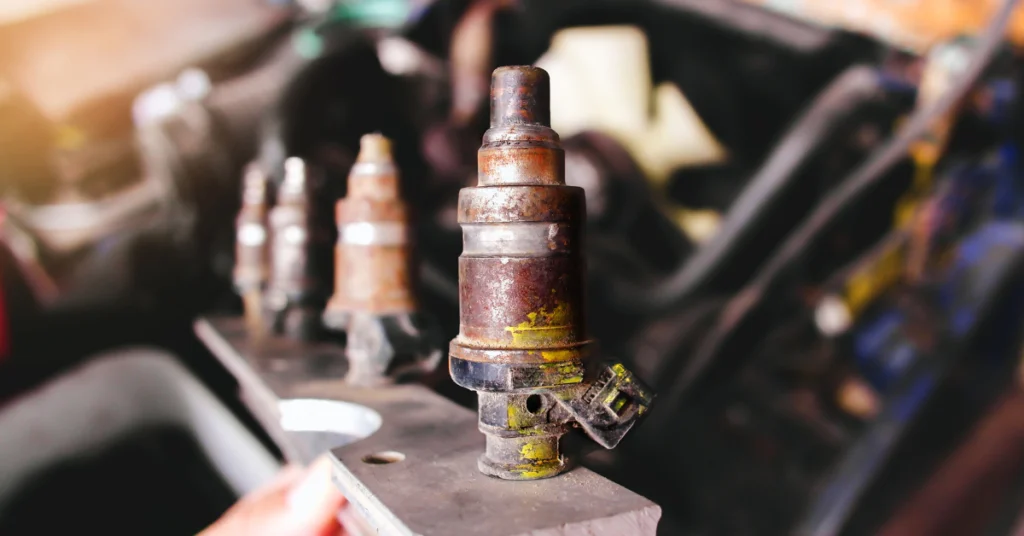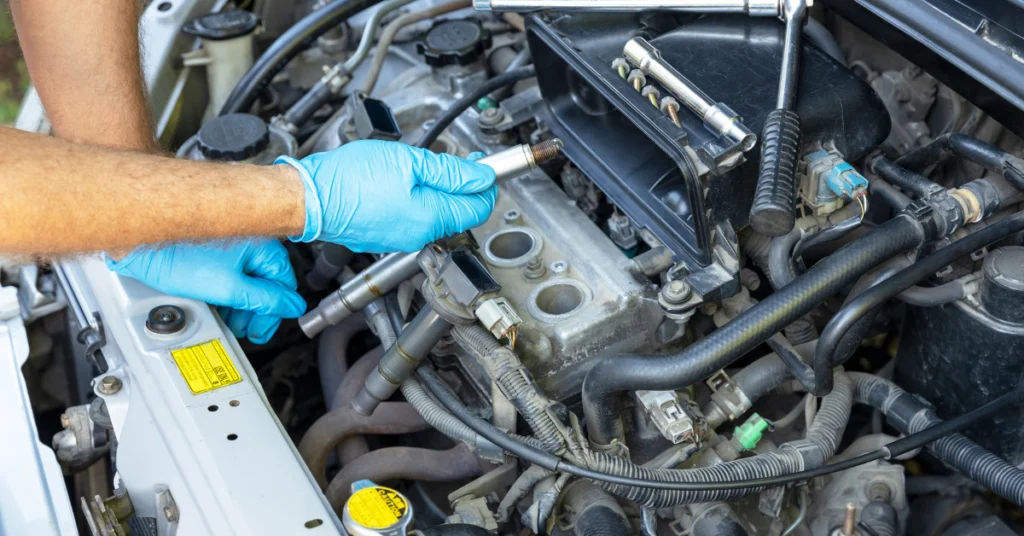
The P0300 Hyundai code in vehicles is a generic powertrain code related to engine misfires. It indicates that the vehicle’s onboard computer has detected a random misfire in one or more cylinders.
When this code appears, it is essential to diagnose and address the issue promptly, as prolonged engine misfires can lead to further damage and potentially expensive repairs.
In this article, we will delve into the causes, symptoms, and possible solutions for the P0300 code in Hyundai vehicles.
Contents
Common Causes of P0300 Hyundai Code
Ignition System Issues
One of the common causes of the P0300 code in Hyundai vehicles is faulty spark plugs, ignition coils, or spark plug wires. Over time, these components can wear out, leading to weak sparks or no sparks at all.
Weak sparks can result in incomplete combustion in the cylinders, causing engine misfires and triggering the P0300 code.
It is important to regularly inspect and replace these components according to the manufacturer’s recommendations.
Fuel System Problems

Insufficient fuel pressure, clogged fuel injectors, or a malfunctioning fuel pump can also contribute to engine misfires and the appearance of the P0300 code.
When an adequate fuel supply does not reach the combustion chambers, misfires can occur.
It is crucial to regularly maintain the fuel system by ensuring proper fuel pressure, cleaning or replacing clogged fuel injectors, and inspecting the fuel pump for any signs of malfunction.
Vacuum Leaks
Leaks in the intake manifold gaskets or vacuum hoses can disrupt the air-fuel mixture going into the engine. This can lead to a lean condition, where there is too much air and not enough fuel, causing misfires and triggering the P0300 code.
Inspecting the intake manifold gaskets and vacuum hoses for any signs of leakage and replacing any damaged components can help prevent vacuum leaks and subsequent misfires.
Faulty Mass Airflow Sensor (MAF)
The MAF sensor measures the amount of air entering the engine and communicates this information to the engine control unit (ECU).
If the MAF sensor is malfunctioning or dirty, incorrect air readings may be sent to the ECU, resulting in engine misfires.
Cleaning the MAF sensor using an appropriate MAF cleaner or replacing it if necessary can help ensure accurate air readings and prevent misfires.
Engine Mechanical Issues
Problems such as low compression, worn piston rings, or a malfunctioning valve train can affect the efficiency of combustion within the cylinders. These mechanical issues can lead to engine misfires and trigger the P0300 code.
Performing a thorough inspection of the engine’s mechanical components, including conducting a compression test, inspecting the piston rings, valves, and valve train, as well as checking the timing belt or chain, can help identify and address any underlying mechanical issues.
In addressing the P0300 code in your Hyundai, it’s crucial to explore the various factors contributing to a random engine misfire. Understanding the common causes shared among different car manufacturers can provide valuable insights into potential solutions.
Symptoms of the P0300 Code in Hyundai Vehicles
When the P0300 code is present in a Hyundai vehicle, drivers may experience the following symptoms:
Check Engine Light
The most obvious indication of the P0300 code is the illumination of the check engine light on the vehicle’s dashboard.
This serves as a warning sign that something is amiss with the engine. It is important not to ignore this warning and to address the issue promptly.
Engine Misfires

Random misfires occur when the fuel-air mixture in the cylinders fails to ignite properly. This can cause engine vibrations, a loss of power, and rough idling.
If you notice any unusual vibrations or rough idling, it is recommended to have your vehicle inspected and diagnosed with engine misfires.
Reduced Fuel Efficiency
Engine misfires can lead to decreased fuel efficiency. If you notice that your Hyundai is consuming more fuel than usual, it could be a symptom of the P0300 code.
Monitoring your fuel consumption and addressing any significant increases can help prevent further damage and ensure optimal fuel efficiency.
Poor Performance
A vehicle experiencing engine misfires may exhibit a lack of power during acceleration or an overall decline in performance.
If you notice a significant decrease in your vehicle’s power or performance, it is important to have it inspected and diagnosed for engine misfires.
Diagnosing and Solving the P0300 Code in Hyundai Vehicles
When faced with the P0300 code in a Hyundai vehicle, it is crucial to perform a systematic diagnosis to identify the underlying cause. Here are some steps to follow:
Check for Other Trouble Codes
Start by using an OBD-II scanner to retrieve all trouble codes present in the vehicle. While the P0300 code indicates random misfires, additional codes can provide additional clues about specific issues that may be contributing to the misfires.
It is important to address all trouble codes present to ensure a comprehensive diagnosis.
Inspect the Ignition System
Begin by checking the condition of the spark plugs, ignition coils, and spark plug wires. Replace any faulty components and ensure that they are properly connected.
It is also recommended to inspect the distributor cap and rotor if applicable.
Regularly maintaining and replacing these components according to the manufacturer’s recommendations can help prevent engine misfires.
Examine the Fuel System

Test the fuel pressure to ensure it meets the manufacturer’s specifications. Additionally, inspect the fuel injectors for any clogs or signs of malfunction.
If necessary, clean or replace them accordingly. Consider checking the fuel pump’s functionality as well.
Regular maintenance of the fuel system, including cleaning or replacing clogged fuel injectors and ensuring proper fuel pressure, can help prevent engine misfires.
Address Vacuum Leaks
Inspect the intake manifold gaskets and vacuum hoses for any signs of leakage. Replace any damaged components and ensure a tight seal to prevent vacuum leaks. Using a smoke machine can help identify hard-to-detect leaks.
Regularly inspecting and maintaining the intake manifold gaskets and vacuum hoses can help prevent vacuum leaks and subsequent misfires.
Clean or Replace the Mass Airflow Sensor
If the MAF sensor is dirty or malfunctioning, it may provide inaccurate readings to the ECU. Clean the sensor using an appropriate MAF cleaner or replace it if necessary.
Regularly cleaning or replacing the MAF sensor can help ensure accurate air readings and prevent engine misfires.
Check Engine Mechanical Components
If all else fails, it may be necessary to perform a thorough inspection of the engine’s mechanical components.
This can involve conducting a compression test, inspecting the piston rings, valves, and valve train, as well as checking the timing belt or chain.
Regularly inspecting and maintaining the engine’s mechanical components can help prevent mechanical issues that can lead to engine misfires.
Clear Codes and Test the Vehicle
After addressing the identified issues, clear all trouble codes and test-drive the vehicle to ensure the P0300 code does not reappear. Monitor the vehicle’s performance for any signs of misfires or related symptoms.
Regularly monitoring the vehicle’s performance and addressing any issues promptly can help prevent further damage and ensure optimal performance.
Conclusion
The P0300 code in Hyundai vehicles should not be ignored, as it indicates the presence of engine misfires.
By diagnosing and addressing the underlying causes promptly, you can prevent further damage to your vehicle and ensure its optimal performance. If you are unsure or uncomfortable performing these diagnostic steps, it is recommended to consult a professional mechanic who specializes in Hyundai vehicles for a comprehensive diagnosis and repair.
Regular maintenance and inspections of the ignition system, fuel system, vacuum system, MAF sensor, and engine mechanical components can help prevent engine misfires and subsequent issues.
FAQ
Q1: What is the P0300 code in Hyundai vehicles?
The P0300 code is a generic powertrain code related to engine misfires. It indicates that the vehicle’s onboard computer has detected a random misfire in one or more cylinders.
Q2: What are the common causes of the P0300 code in Hyundai vehicles?
The common causes include ignition system issues (faulty spark plugs, ignition coils, or spark plug wires), fuel system problems (insufficient fuel pressure, clogged fuel injectors, or a malfunctioning fuel pump), vacuum leaks (in the intake manifold gaskets or vacuum hoses), and a faulty Mass Airflow Sensor (MAF).
Q3: What are the symptoms of the P0300 code in Hyundai vehicles?
The symptoms include the illumination of the check engine light, engine misfires (vibrations, loss of power, and rough idling), reduced fuel efficiency, and poor performance (lack of power during acceleration or overall decline in performance).
Q4: How can the P0300 code in Hyundai vehicles be diagnosed and solved?
A4: Steps to diagnose and solve the code include checking for other trouble codes, inspecting the ignition system, examining the fuel system, addressing vacuum leaks, cleaning or replacing the Mass Airflow Sensor (MAF), checking engine mechanical components, clearing codes, and test-driving the vehicle.



